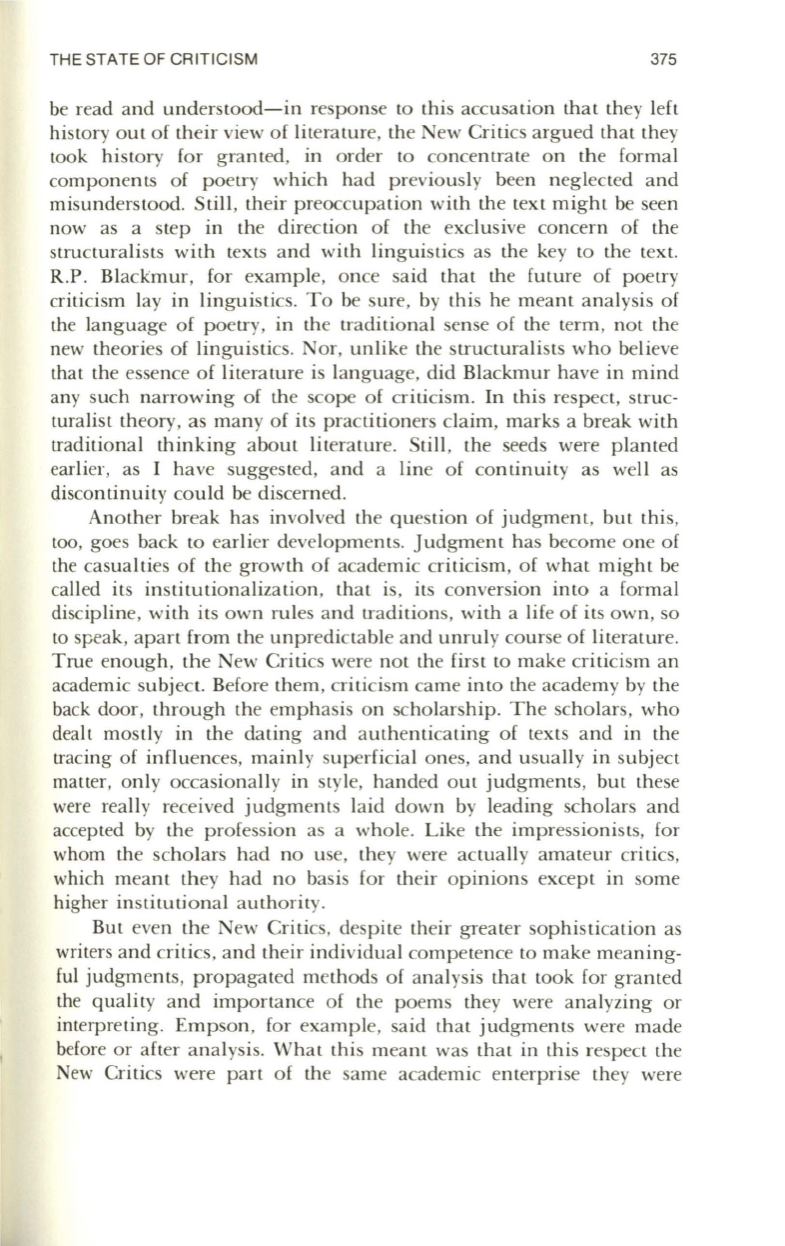
THE STATE OF CRITICISM
375
be read and understood-in res ponse to this accusa tion tha t they left
history out o f their view o f litera ture, the ew Critics argued tha t they
took hi story for g ranted, in order to concentra te on the formal
components o f poetry which had prev io usly been neglected and
misunderstood. Still, their preoccupa tion with the text might be seen
now as a step in the direc tio n o f the exclusive concern of the
structuralists with texts and with linguistics as the key to the text.
R.P . Blackmur, for example, once said tha t the future o f poe try
criticism lay in linguistics. T o be sure, by this he meant a na lys is of
the lang uage o f poe try, in the traditional sense o f the term, not the
new theories of lingui stics. Nor, unlike the structuralists who believe
tha t the essence o f litera ture is language, did Blackmur have in mind
any such na rrowing of the scope of criticism . In this respect, struc–
turalist theory, as many o f its prac titi oners claim, marks a break with
traditio na l thinking about litera ture. Still , the seeds were planted
earlier, as I ha ve sugges ted, and a line o f continuity as well as
discontinuity could be discerned .
Ano ther break has invo lved the ques tion of judgment, but thi s,
too, goes back to earlier developments. Judgment has become one of
the casua lties of the growth o f academic criticism, o f wha t might be
called its institutionaliza tion, tha t is, its conversion into a forma l
disc ipline, with its own rules and traditions, with a life o f its own, so
to
speak, apa rt from the unpredictable and unruly course o f litera ture.
True enough, the New Critics were no t the first to make criticism an
academic subj ec t. Before them, criticism came into the academy by the
back door, throu gh the emphas is on scho larship. The scho la rs, who
dealt mos tl y in the da ting and a uthentica ting o f texts and in the
tracing of influences, ma inl y superficial ones, and u sua ll y in subj ec t
matter, only occasionall y in style, handed out judgments, but these
were reall y received judgments laid down by leading sch o la rs and
accepted by the p rofess ion as a who le. Like the impress ionists, for
whom the scholars had no use, they were ac tuall y ama teur cnucs,
which meant they had no bas is for their opinions except in some
higher instituti o na l authority.
But even the New Critics, des pite their grea ter sophistica tion as
writers and critics, and their individual competence to make meaning–
ful judgments, propaga ted methods o f ana lys is tha t took for g ranted
the quality and importance o f the poems they were ana lyzing or
interpreting. Empson, fo r example, sa id tha t judgments were made
before or after ana lysis. Wha t this meant was tha t in this respect the
New Critics were part o f the same academic enterprise they were


